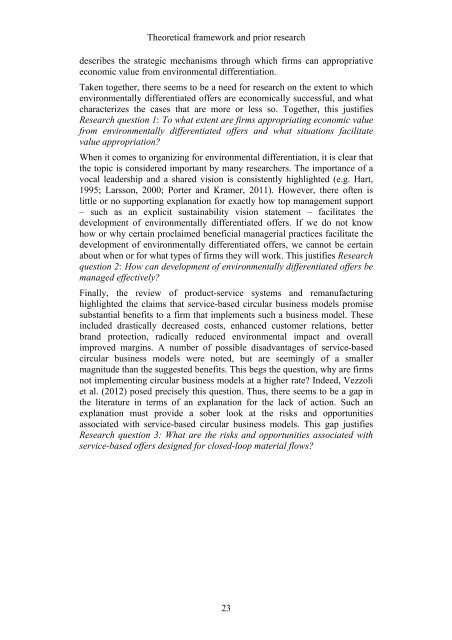Paper separationsblad - Chalmers tekniska högskola
Paper separationsblad - Chalmers tekniska högskola
Paper separationsblad - Chalmers tekniska högskola
Create successful ePaper yourself
Turn your PDF publications into a flip-book with our unique Google optimized e-Paper software.
Theoretical framework and prior research<br />
describes the strategic mechanisms through which firms can appropriative<br />
economic value from environmental differentiation.<br />
Taken together, there seems to be a need for research on the extent to which<br />
environmentally differentiated offers are economically successful, and what<br />
characterizes the cases that are more or less so. Together, this justifies<br />
Research question 1: To what extent are firms appropriating economic value<br />
from environmentally differentiated offers and what situations facilitate<br />
value appropriation?<br />
When it comes to organizing for environmental differentiation, it is clear that<br />
the topic is considered important by many researchers. The importance of a<br />
vocal leadership and a shared vision is consistently highlighted (e.g. Hart,<br />
1995; Larsson, 2000; Porter and Kramer, 2011). However, there often is<br />
little or no supporting explanation for exactly how top management support<br />
– such as an explicit sustainability vision statement – facilitates the<br />
development of environmentally differentiated offers. If we do not know<br />
how or why certain proclaimed beneficial managerial practices facilitate the<br />
development of environmentally differentiated offers, we cannot be certain<br />
about when or for what types of firms they will work. This justifies Research<br />
question 2: How can development of environmentally differentiated offers be<br />
managed effectively?<br />
Finally, the review of product-service systems and remanufacturing<br />
highlighted the claims that service-based circular business models promise<br />
substantial benefits to a firm that implements such a business model. These<br />
included drastically decreased costs, enhanced customer relations, better<br />
brand protection, radically reduced environmental impact and overall<br />
improved margins. A number of possible disadvantages of service-based<br />
circular business models were noted, but are seemingly of a smaller<br />
magnitude than the suggested benefits. This begs the question, why are firms<br />
not implementing circular business models at a higher rate? Indeed, Vezzoli<br />
et al. (2012) posed precisely this question. Thus, there seems to be a gap in<br />
the literature in terms of an explanation for the lack of action. Such an<br />
explanation must provide a sober look at the risks and opportunities<br />
associated with service-based circular business models. This gap justifies<br />
Research question 3: What are the risks and opportunities associated with<br />
service-based offers designed for closed-loop material flows?<br />
23















